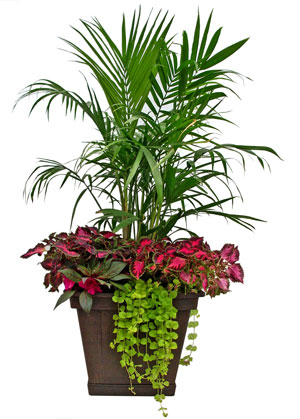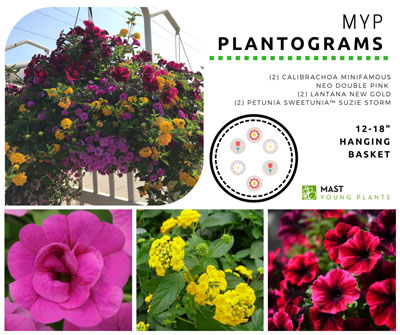3/1/2023
My Way
Michael DeBerti

I’m not referring to Frank Sinatra’s late ’60s hit “My Way,” but am referencing the act of being a do-it-yourself individual who likes to think outside of the box and do things in a specific way.
Creativity is key in today’s horticulture market. We all need to catch the eye of our customers and we don’t always have to rely on our breeders to do it.
In the current market, the breeders of today all have been offering combination liners and recipes of their genetics in a series of groupings to help make it more convenient to produce a combination. These combinations all have plants that will grow together nicely and produce a great planting. The guesswork of what goes with what is somehow taken care of and the success rate of a nice planter is created with minimal planning. The convenience is a great tool for today’s production, but what if you like thinking outside the box? What if we want to incorporate multiple breeders in a single combination? What if I like things “my way”?
Pictured: A combination with multiple breeders’ genera.
My company routinely produces several breeders’ combination liners and every year we display them in our show garden for the summer. I know a lot of research on compatibility goes into them, and they do demonstrate the art and beauty of a great planting. But what if you’re the grower who, like me, enjoys doing things yourself and thinking outside the box?
I’m a bit of a risk-taker, one who’s willing to create something out of the ordinary. Because of this, I create my own combos for our yearly show garden every summer. I’m that individual who wants to design something unique to call my own. Doing my own combo designs allows me to reach out to all the available genetics offered to the grower. Cross-breeder genetic combinations can deliver some high-impact distinctiveness in a program.
I’ve had the opportunity to give a few talks on combo creation and I’ve found a lot of interest on the do-it-yourself design. Many have asked the secret to designing a nice combo. No secrets, but I do have a couple guidelines that I’ll share. My process begins with this: plan your work and work your plan. With a good plan, you, too, can become a successful designer.
Find one key plant that you’d like to build a combination around. It can be any one of the standard categories of plants called Filler, Thriller or Spillers. I also like to throw in a fourth attribute: a Surprise. This is something unexpected in a combination to meet the demand for more unique plantings. This may mean adding something that normally wouldn’t be in our usual annuals’ design. Placing a foliage plant, succulent, woody ornamental or a first-year flowering perennial can make the surprise element in the design. This can change the look and create an upscale combination that will assuredly bring in a high retail dollar and give the customer more than what they expect to see in a combination. It also can give the customer the opportunity to keep something after the season, something to either plant in their garden or bring indoors to keep for a longer season of enjoyment.
Select the color scheme, texture or habit to complement the plant, and try to pair plants with similar vigor. This will help the combination keep its shape and desired balance of each input plant. I always refer to the catalogs that provide a height and width spec in the plant’s description when making my design plan. This helps maintain a consistent growth habit throughout the season. We’ve all had a plant or two claim dominance in a combo and leave us with a monoculture planting. Watching the vigor can minimize this issue. It'll take some planning and research, but it’s doable and opens the possibility of using different breeders’ genera in a planting.
 Pictured: An example of a Plantogram from Mast Young Plants’ website.
Pictured: An example of a Plantogram from Mast Young Plants’ website.
You may wonder what to do if your vision calls for non-compatible plants that have differing vigor. With this issue, I’ve found two possible solutions: First, consider plant placement in the container. Placing only one pinched aggressive genera in the middle of the planting can slow it from choking out the rest of the plants. It’ll branch out, making a better filler. If it’s meant to be a trailing plant, planting it to the front of the planter with a pinch will encourage the plant to spill over the container.
Second, use a PGR prior to planting. This will help slow the vigor down on the selected aggressive plant. I’ve found that the procedure of liner dips will keep them in check. Sitting the young plant in a solution of 1 to 3 ppm Paclobutrazol for 30 to 60 seconds before transplanting can have a positive effect on the aggressive genera, giving way to creating a combination that may not have been possible under normal planting. This technique opens the availability to mix many genera that would normally create a monoculture container in the end. (Please allow the plant to sit for recommended worker protection standards before planting.)
Designing it yourself creates a whole new aspect of mixing it up with today’s plant availability. Get creative with varieties and mixes, and plan the design. With these recommendations, you should be well on your way to getting your customers’ attention with your own designs and enjoying that feeling of doing things your way. GT
Michael DeBerti is Senior Grower for Mast Young Plants in Grand Rapids, Michigan.